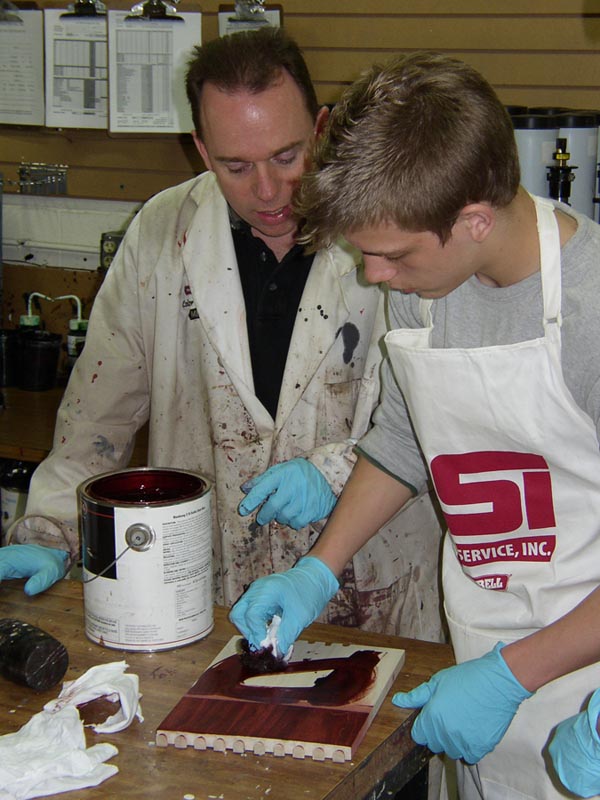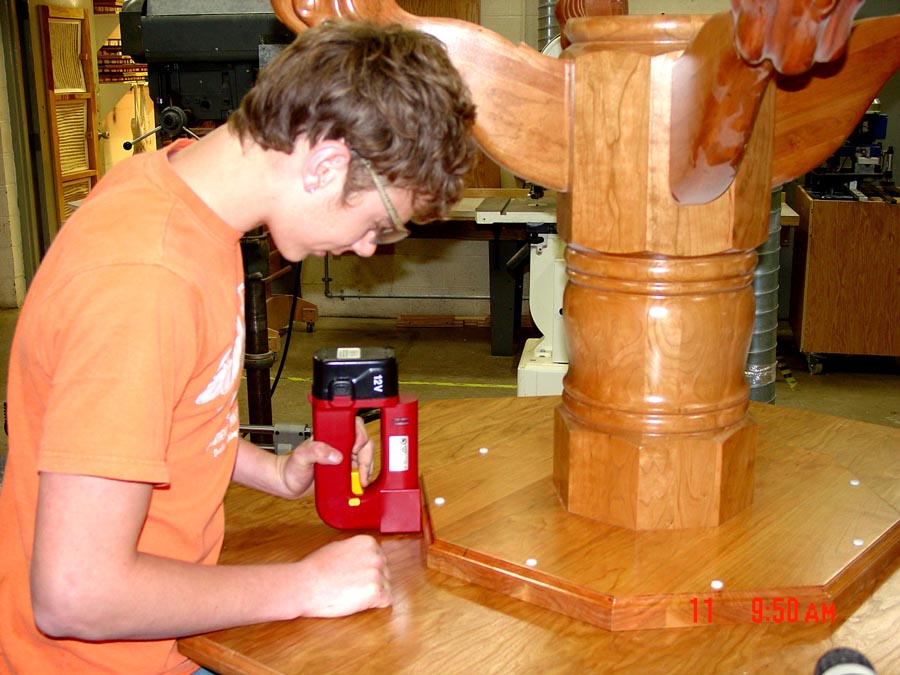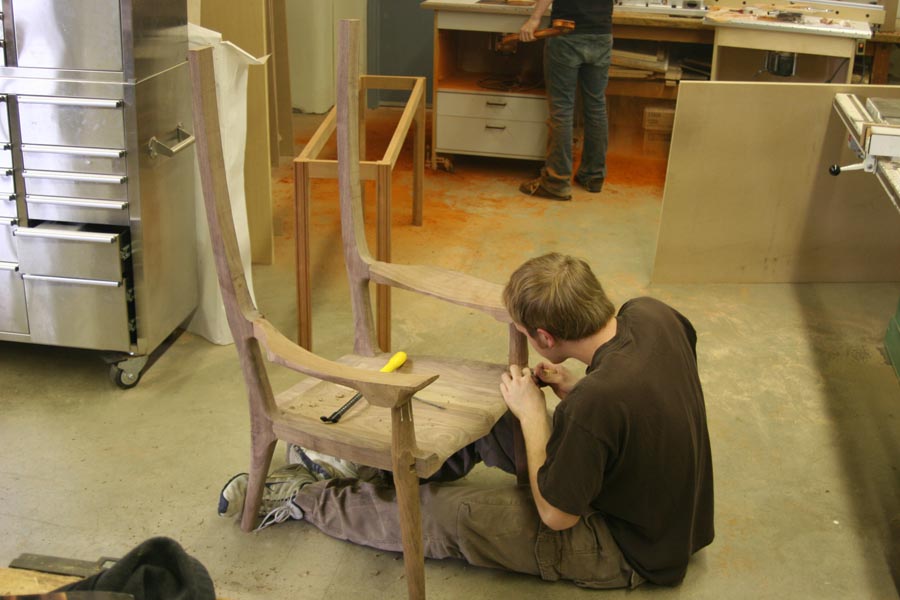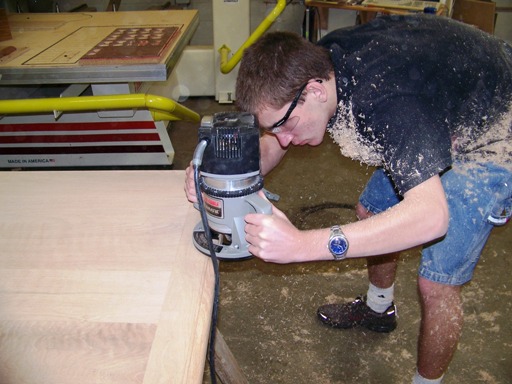
“Having gone through the education system in America,” lamented Mark Smith, the National Program Director of WoodLINKS here in the US, “I went on to college, because I was told that was what I must do. In fact, I had a great Industrial Arts (IA) program in high school, but it nevertheless carried the onus that what you did there was simply a hobby and had no value beyond that. Never once did anyone ask me if I considered woodworking as a career choice.
“Increasingly, the IA programs in high school are not respected because the education system views them as teaching a hobby rather than real world skills. No Child Left Behind (NCLB) actually makes things worse for IA by encouraging teachers to teach toward academic testing rather than teaching what the local and national community needs. NCLB makes it more difficult for students to take electives like woodworking: there is simply not enough time in their schedule.
“As a result, not only are good people not being steered toward vocational education; they are actively steered away from it. It’s documented that as you remove vocational education from a school system, graduation rates plummet. Meanwhile, only 15 percent of our nation’s students graduate from a four-year college, while the wood industry is screaming for skilled workers.
“Fortunately, there is WoodLINKS, an industry driven nonprofit whose goal is to help the education system produce skilled workers for the wood industry, as well as students who want to go on to college for a degree in wood-related fields. We work with high schools, one at a time, showing them that the wood industry is a great one to get involved with, and showing them how to do it.
“WoodLINKS actually started in Canada with the realization that industry needed to help education, and that in turn would help industry. Their mindset was not quite as academically slanted as ours, and was more positive toward the industry. Up there, the Canadian government backs WoodLINKS. Here, only industry does.”
WoodLINKS came along a bit too late to help Mark, but he managed to channel his education, and frustration, into helping them. “I got a degree in industrial technology with teacher certification,” he recounted, “and became an Industrial Arts teacher. I taught for 13 years, but it was a constant battle. I saw cases where high school counselors actually told students, in so many words, that woodworking was not a worthwhile endeavor to pursue.
“I knew that if my own program was going to be successful and relevant, I had to get industry involved and get the local school system involved. I also knew that if I could get industry involved, I could win over the school system. Everywhere I went, I made contacts with industry people; I networked, and started developing an industry support system. That meant that if I had a technical question, I or my students could contact a company and get a real world answer, and we had constant contact via the web, email and by phone.
“At least once a year, I would attend an industry trade show. In 1999, the year WoodLINKS first came down to the U.S. from Canada, I met Jerry Finch staffing their booth at the show. WoodLINKS seemed to share my vision, so I told them I wanted to get involved. They invited me to go to [the International Woodworking Fair] in the summer of 2000, where I was first exposed to just how high-tech the wood industry had become. It also validated what I always believed: that the wood industry is a good career choice.
“In order to get kids to see what the woodworking industry really is, WoodLINKS offers both curriculum guidelines and certification based on those guidelines. They also encourage students to get internships and higher education in the field. I wanted my school to be part of that, which meant I had to agree to get involved in WoodLINKS and pay a one-time site license fee of five thousand dollars. I was hooked, and soon became a WoodLINKS teacher. Then in June of 2007, I became the National Director.
“Their site license agreement ensures the teacher gets up-to-date training to familiarize students about the current conditions, processes and careers in the wood industry. When you come on board, they offer the school a $120,000 donation package in the form of software, hardware, materials and teaching tools. That’s a pretty hefty immediate return on a five grand investment.
“For instance, one of our supporters, Fastcap, essentially sends us whatever we ask for to be used in the classroom free of charge. Other companies offer free wood, veneer, tools, software and a host of things that schools can’t normally get because of limited budgets, and it is all supported by the industry. They even pay for teachers to fly down to IWF, attend classes, and so on. Some of the companies supporting WoodLINKS include such familiar names as Mastercam, Microvellum, Fastcap, Franklin Adhesives, Hafele, Festool, Rikon, Veneer Tech, Thermwood, ShopBot, Stiles and many others, in addition to major industry show organizers such as TSI Expos, IWF [International Woodworking Fair] and AWFS [Association of Woodworking and Furnishings Suppliers].
“For their part, WoodLINKS requires proof of students getting placed in jobs, internships and post secondary education. The teacher is also encouraged to put out a newsletter that goes to students, industry partners, and to WoodLINKS. What we are encouraging is a dynamic shift in how industry and education work together. At present, it seems that industry and education simply do not understand or communicate with one another.
“We’d like to affect the public and education system’s perspective, and that ultimately means affecting the government’s view as well, because it is the government that runs the education system. At the moment, we are surviving without their direct involvement, but we descend upon Washington once a year to meet with legislators and government officials to talk about what we think is important.
“Of course, no teacher knows everything. Any woodworker, professional or hobby level, knows things that the local IA teacher does not. To make use of that, local hobby and professional woodworkers will often come in and teach various techniques to our students. WoodLINKS encourages that by helping the teachers develop this local support network, helping them find the right people, and showing them how to make those contacts. Many hobby woodworkers, like your readers, contact us to see how they can help once they find out about us.”












